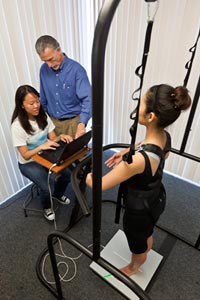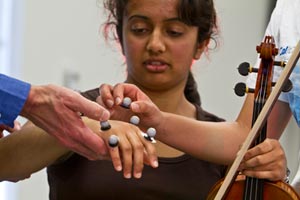
Integrated Nanosystems Research Facility
Science of Dancing
 “Raising the Barre”
“Raising the Barre”
By Lori Brandt | Interface Magazine
If feet could talk, those belonging to a dancer would probably have much to say. And Jeff Russell, assistant professor of dance science, is listening.
Russell uses innovative technology in Calit2’s eHealth Collaboratory to study the demands of dance on the musculoskeletal system. Russell and his team intend to learn from the feet of tap dancers by developing a custom insole for tap shoes. A thin layer of laminate is embedded with sensors and accelerometers to measure pressure and acceleration of the feet, and a data-logging chip collects the numerical values of force that a dancer’s feet undergo while tapping.
Russell oversees 18 students from various disciplines conducting dance science research at the forefront of the field. Alison Ozaki, a biological sciences student and former tap dancer, remembers her own shin pain. “The rapid percussive footwork performed in tap suggests that the foot and ankle sustain stresses that could lead to injuries,” explains Ozaki, who collaborates with biomedical engineering graduate student Peyton Paulick to design the insole.
The partnership is producing more than a shoe insert. “With people who excel in different subjects working together, discussions about possibilities are more open,” Ozaki says. “It’s rewarding to see there’s something we all have in common and that is the desire to learn more.”
Russell’s applied research projects, which run the gamut from detecting bacteria on the barres in dance studios to studying joint flexibility and range of motion in dancers’ ankles, all bridge the arts and sciences.
“Everything I’m working on has to do with understanding the demands put on the body from dance or performing,” says Russell, a certified athletic trainer, who has 30 years of experience in sports medicine, orthopaedics and dance medicine. “Once we grasp that, we can determine how to make it less demanding and how to physically condition in specific areas.
“Most people don’t think of dance as athletics,” he adds. “But in many ways, it is just as rigorous as sports, especially in terms of the hours of practice, repetitive motion and physical demands on the body.”
Two of his students are comparing balance in dancers and non-dancers. Laura Obler, majoring in dance and chemistry, and Tiffany Yu, a biological sciences major, seek to understand how dance training affects balance and what patterns people demonstrate as they try to maintain postural stability. They are using a balance platform equipped with sensors to measure and compare the degree of sway exhibited while standing on two feet and on one foot.
“This information will help us with dancers, but we may also be able to transfer it to other populations such as the elderly, who have a high risk of falling,” Russell explains.
The balance platform is just one of the high-tech tools in Russell’s arsenal that has applications across disciplines. He also works with a motion capture system to collect biomechanical data. Typically used to create realistic animations in film and video games, motion capture technology has also been applied to artistic endeavors and movement analysis in orthopaedics, rehabilitation and sports.
 But Russell also sees the technology’s potential for scientific research in performing arts. He employs six high-speed cameras with visible red and infrared light sources that track the movement of reflective markers taped strategically to a dancer’s or musician’s body. Special computer software combines the information from the cameras into a graphic representation, or stick figure, on a computer screen.
But Russell also sees the technology’s potential for scientific research in performing arts. He employs six high-speed cameras with visible red and infrared light sources that track the movement of reflective markers taped strategically to a dancer’s or musician’s body. Special computer software combines the information from the cameras into a graphic representation, or stick figure, on a computer screen.
Russell recently tracked the movement patterns, joint angles and speed of a professional wheelchair dancer to establish a baseline for training. And he’s just begun a motion capture study to look at the upper body of violinists, who often experience neck and back pain from the strenuous position required to hold their instrument.
“If we can map a performer’s motions in a way that allows us to see what kinds of movement patterns are leading to painful overuse syndromes, then we can determine how to change the way we teach techniques to reduce injuries,” Russell says.
David Reinkensmeyer, professor of mechanical and biomedical engineering, and anatomy and neurobiology, also is interested in studying human mobility. He designs technology that helps people recover from neurological trauma, such as stroke and spinal cord injury, and he committed funds to buy two of the cameras for Russell’s system.
“There are about 30 faculty on campus with the goal of improving movement training, rehabilitation and exercise through new technologies,” Reinkensmeyer says. “Russell’s work and the motion capture system could be a helpful resource for us all.”
Russell and eight of his students will be presenting their projects at the International Association for Dance Medicine and Science’s Annual Meeting this fall in Washington, D.C. Russell, who says dance science and medicine lags about 20 years behind sports medicine, couldn’t be prouder. “If I can graduate students who know what I know, do what I do and expand our exploration, we’ve got multiplication, and we’ll see a real advancement of the field. Then we will have accomplished something.”



